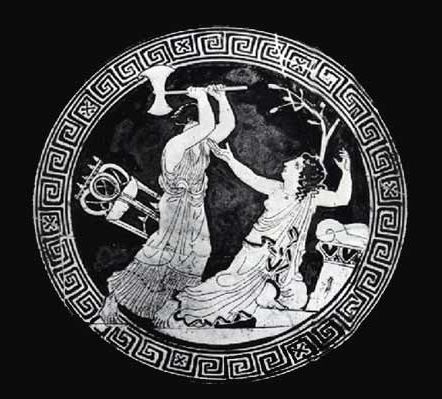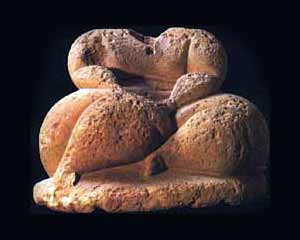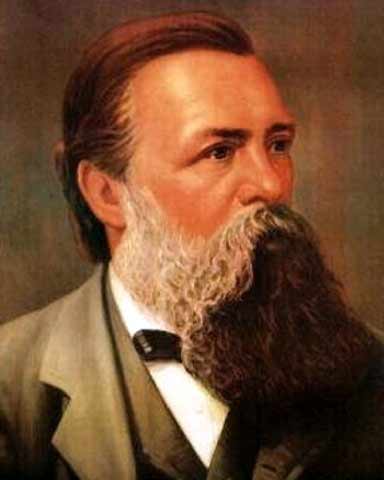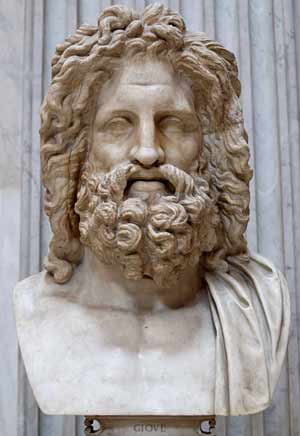
A misogynist myth – Klytemnestra takes an axe
to wayward husband Agamemnon
Neil Faulkner Archive | ETOL Main Page
Marxist History
Published online by Counterfire, 1 November 2010.
Copied with thanks from the Counterfire Website.
Marked up by Einde O’Callaghan for the Encyclopaedia of Trotskyism On-Line (ETOL).
Neil Faulkner looks at how the growth of private property altered the position of women – from occupying a central role in society to suffering what Engels called ‘the world historic defeat of the female sex’.
 A misogynist myth – Klytemnestra takes an axe |
Myth, ritual, and religion are multi-faceted. Their deepest root lies amid the chronic insecurity of primeval hunter-gatherer existence. Anxiety about the food-quest was assuaged by magical representations of the beasts of the hunt in art, dance, music, and personal ornament.
Early farmers, equally prey to the vicissitudes of nature, conceived of the Earth as a mother-goddess, a fount of fertility and food, who could be begged and bribed into delivering her bounty.
The fertility deities of early farmers were invariably female. The woman – menstruating, giving birth, lactating – was the obvious symbol of natural fecundity. But there was another reason that god was a woman.
 Neolithic earth-mother figurine |
Real women were powerful in pre-class societies. Descent was often matrilineal (registered through the female line), residence matrilocal (in the wife’s village, not the husband’s), and authority matriarchal (women’s voices dominant).
Why was this? Because women were the fixed points in simple societies based on co-operative labour and collective ownership. Their child-bearing and child-feeding functions made them less mobile, both geographically and socially, and the absence of private property, and the privileges to which private property gives rise, precluded alternative sources of social power.
Women were society’s centres of gravity. Men orbited around them. The great earth-mother goddess of early farmers was the mental mirror of a social reality.
Private property, class division, and state power rose in tandem, the one dependent upon the other. Sharing and a rough equality were intrinsic to communal property. But the division of land into private farms, or of cattle into separate herds, allowed some to grow rich at the expense of others. The resulting tensions necessitated control if society was not to fall apart. The state – armed bodies of men – defended the new property-based status quo.
Now, men had power. For, it was men, not women, who herded the stock and ploughed the fields. When stock and fields were held in common, they were for the benefit of all. When they were held as private property, they enriched and empowered those who worked them.
 Frederick Engels talked of ‘the world-historic |
What Frederick Engels called ‘the world historic defeat of the female sex’ was represented in myth and ritual. The old mother-goddesses were cast from their thrones. A new generation of male power-deities replaced them. The Greek heaven was ruled by Zeus, the Roman by Jupiter, the Jewish by Yahweh, the Arab by Dushara; and so on, across the world.
And just as the old earth-mothers symbolised the forces of nature, the new power-deities symbolised those of tribes, city-states, and empires. A mythic superstructure was implanted in the mind as a military one was constructed in reality.
At Olympia, the holiest site in ancient Greece, the oldest cults were those of the mother-goddesses Gaia, Rhea, Hera, and Demeter. But by the Classical Age, the 5th and 4th centuries BCE (before the common era), they had long since been displaced, and it was Zeus who was honoured with the richest offerings, the grandest temple, and the famous games.
In the ‘War of the Giants’ myth, Zeus leads the new gods to victory over Kronos and the old gods. Zeus represents order, patriarchy, and civilisation. Kronos is the embodiment of barbarism: his is a world of chaos, barbarism, and mother-right.
Matriarchy became myth-code for a world of disorder. When the Greek hero Agamemnon returns home from the Trojan War, he is slain by his own wife, who has taken another man as lover and king. The world is turned upside down, and the moral order collapses. The dead man’s son slays his own mother in vengeance. Murder begets murder. A cycle of slaying is the price of woman-power.
Misogynist myth sanctified Greek civilisation’s patriarchal order. The male-run oikos (a property-owning household) was the basic building-block of the social structure. The city-state was run by assemblies of citizen-men, of oikos-patriarchs, of small property-owners. Not the least of the contradictions that doomed Greek democracy was the political exclusion, social segregation, and domestic oppression of women.
 Zeus – a male usurper of divine power |
Other social tensions also found expression in the myth-worlds of ancient peoples. Myths are good to think with. They provide ways of describing, narrating, and analysing social contradictions. They represent and project social norms, but they also debate them when they are contested.
Who are we? Where have we come from? Which others are our friends, and which our enemies? In a divided world, what is it that defines us, unites us, and enables us to fight with conviction for our place in it?
Cultural identities are forged in struggle, and it was myth, ritual, and religion that give them form and expression in the ancient world. Rome was a class-ridden, militaristic, imperial state. Little wonder that its supreme deity was a ghastly war-god.
Jupiter Optimus Maximus – Best and Greatest – was the patron deity of the city-state of Rome. As such, in the totemic form of an eagle, he was carried into battle on the standard of every Roman legion. As such, he was worshipped at special altars in every army-camp in the empire. And as such, he was the recipient of sacrifice and honour at the climax of every Roman triumph, when victorious troops and enslaved captives were paraded through the city, and defeated enemy leaders were ritually strangled in the Forum.
But if the violence and exploitation of empire had its religious expression, so did the resistance of the oppressed. Myth could both legitimate the social order and inspire resistance to it.
One ancient faith stands out in this respect. Over centuries of struggle, it was forged into an iron cudgel of counter-cultural resistance, resilient, ineradicable, deep-rooted in the hearts and minds of the common people of Palestine.
Later, it would spawn two children, also weapons of ideological struggle, and between them, these three religious faiths would eventually conquer half the world. They are Judaism, Christianity, and Islam.
Though capable of endless recasting as deeply conservative ideologies, the three great monotheistic religions produced by the contradictions of the ancient world owe their extraordinary power to their origins in the myths and rituals of the oppressed.
This will require further discussion.
Neil Faulkner Archive | ETOL Main Page
Eleven Reasons to Fight
Last updated on: 14 February 2022